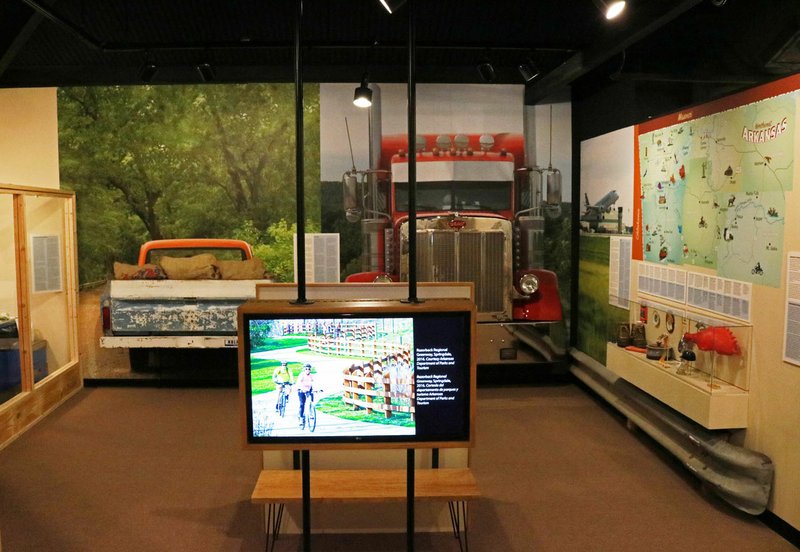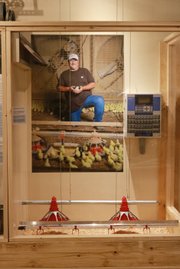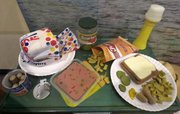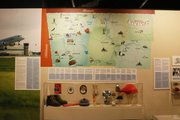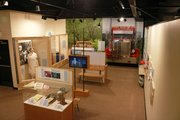FAQ
‘Modern Times:
1950 To Present’
WHEN — Opening this weekend
WHERE — Shiloh Museum of Ozark History in Springdale
COST — Free
INFO — 750-8165
In the months she spent considering the latest new gallery at the Shiloh Museum of Ozark History, two words kept "bubbling up" for outreach coordinator Susan Young: Growth and change.
"That's kind of the underlying message throughout this section of the exhibit hall," says Young of "Modern Times: 1950 To Present," the fourth gallery renovated over the last 28 months at the Springdale museum. "So what you have driving that, what's underneath all of this growth and change, is a key player fundamental to everything else: The creation of Beaver Lake -- the fuel for our economic engine. We could not have grown or continue to grow without this water supply -- industrially, commercially, residentially, at the university. So Beaver Lake became a key part of the story," expanding naturally to include agriculture, retail, tourism, transportation and the University of Arkansas.
"We have the big players -- Tyson Foods, Walmart, J.B. Hunt -- but the story I pitched and the rest of the team accepted was to focus on the everyday folks," Young explains. "That's what we do here. Sam's story is told in the Walmart Museum. Everybody knows the Tyson Foods story. We wanted to focus on the unsung people who helped make these billionaires in our back yard."
Walk into the new gallery, which follows its predecessors in chronological order, and on your left is artist Liz Lester's map of the lake, created by damming the White River in 1966.
"It shows there were costs with bringing in that lake," says Young. The map illustrates "old fords and ferry crossings, some of the old communities, where cemeteries were removed by the Corps of Engineers, archeological sites now underwater. It includes a lot of places we can't go anymore."
On a knee-high "dock," a picnic is laid out as it might have been in the 1960s or '70s, complete with fishing gear, a transistor radio and "a beautiful array of fake food" fashioned by Marie Demeroukas, Shiloh Museum photo archivist and research librarian. "It is the most jaw-dropping thing in there," says Young of the Vienna sausage, olive loaf for sandwiches and Fritos. "It's incredible -- as real as it can be."
It might not qualify as the most overwhelming, though. Enter the gallery and turn right, and you're looking squarely into the grill of a full-size, candy apple red Peterbilt semi truck. Curtis Morris, the museum's exhibits manager, explains that it includes real parts scavenged from a truck shop in Joplin, Mo., backed by a giant photograph taken by museum photographer Kris Johnson.
"It was harder than it looks and not as hard as it looks," Morris says of installing an 18-wheeler in a museum. "It's all fiberglass, so it weighs less than the pickup truck next to it."
Yes, Morris managed to slice off the back end of a 1968 Chevrolet pickup, fill its bed with produce sacks and attach it to the wall next to the Peterbilt.
"It took some engineering to keep it from falling off the wall," he admits. "That bumper is steel." Supported by steel tubes onto the floor, the bumper is so secure the museum staff has jumped on it to test it, Morris says. "It won't fall."
"We did this all in house," Young reminds. "That's what's amazing. We brought ideas to Curtis, and he said, 'I'll make it work.'"
Young says perhaps the most difficult part was wrapping her head around an exhibit that essentially chronicles her lifetime.
"This is new stuff, so it's not like I could stand on the shoulders of historians who have had the distance of decades to analyze history," she says. "A lot of the [objects] we had to go look for, because we haven't collected a lot of things from our more recent history. We've been too busy trying to save the really old things!"
A photograph from the museum's vast collection of over half a million images inspired an exhibit on the poultry business. In it, a farmer hand feeds his chickens from a massive hopper sometime in the 1950s. Travis Gates at RCDC Poultry Equipment, consulted about the technology of a 2017 chicken house, happened to have a similar hopper being used as a watering trough at his dad's farm. He donated it, and Morris installed it to show how it would have functioned.
Next door, of course, is a scene representing the modern equivalent, a $250,000 chicken house the farmer can manage from his smartphone.
"The rise of the poultry industry, the rise of retail, the rise of transportation -- all those things are interconnected," Young says. "Then you have the UA, a major employer and something that sets this region apart. And you have tourism, long a standard of economic success. But tourism in this time period shifts from people coming to look for the hillbillies to people coming to see a world class art museum to Hollywood coming to Bentonville for the film festival."
Once again utilizing the museum's photo collection, a "slide-show" style exhibit in the center of the gallery takes viewers through the decades; another one looks at the "back to the land" movement and includes a Corona grain mill, a mainstay to those families; and a third considers military service as it looked to a Vietnam veteran and to a modern-day veteran serving in Iraq and Afghanistan, one chronicled in a letter, the other in an email to her family.
"You can't tell every story," Young says. "But I hope we've done a fair job giving food for thought about those two things -- growth and change -- driven by personal stories of everyday people."
NAN What's Up on 09/15/2017

